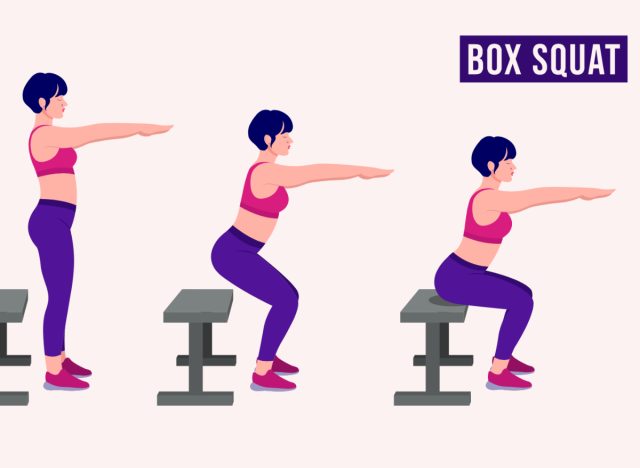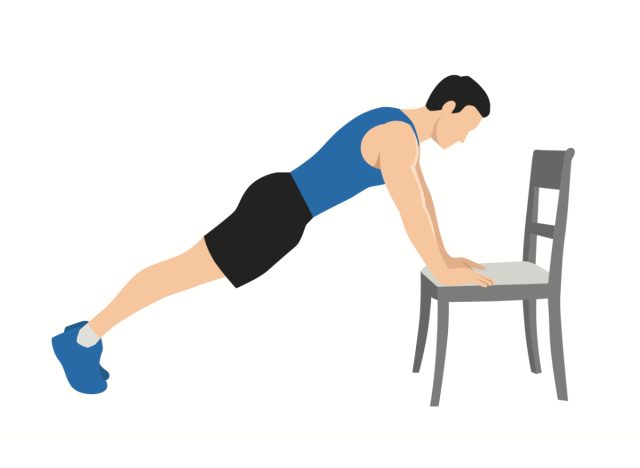Maintaining physical strength is an essential component of healthy aging. Regular exercise is one of the most effective ways to help ensure your body remains strong and functional as you age. Strength training in particular is crucial for maintaining muscle mass and bone density, both of which decline with age, MedlinePlus explains. However, not all strength training exercises are equal—especially for those in their 50s. That’s why we spoke with an expert who breaks down nine of the best strength exercises to stay fit in your 50s.
Growing older means your body becomes less flexible, and you have a greater chance of suffering from injury, The Institute for Arthroscopy & Sports Medicine, San Francisco points out. As a result, activities you once did with ease may need to be modified to suit your current fitness level. That’s why it’s essential to choose safe and effective exercises for your body’s changing needs. Fortunately, Samantha McKinney, CPT, a certified personal trainer with Life Time, shares nine stellar strength exercises to stay fit in your 50s.
The below moves will help you achieve optimal fitness and health. They’ve been selected based on their effectiveness in building strength and preventing injury and their suitability for older adults. By incorporating these exercises into your fitness routine, you’ll stay fit and strong and reduce your risk of injury and age-related health problems. Keep reading for McKinney’s rundown of each exercise, then check out The 8 Best Exercises for Men to Stay Fit After 50.


“Squatting is one of the best ‘bang for your buck’ exercises, as it recruits large muscle groups, helps control blood sugar (which is essential for fat loss), and improves overall metabolism as muscle builds,” says McKinney.
Begin by standing in front of a knee-height box or a workout bench with your feet hip-width distance apart or slightly wider. Keep your abs engaged, and slowly squat down, lowering your glutes toward the box. Pause as you sit on the box, but keep your abs and glutes engaged. Finally, drive through your heels to stand.
If you want more challenge, increase the weight by placing a barbell across your shoulder girdle or holding dumbbells near your shoulders in a front rack position.


“Hinging movements are essential to any effective strength training program designed to optimize body composition,” states McKinney. “They work your backside, which is under-firing for many people due to more sedentary lifestyles and sitting.”
To perform a glute bridge, lie on your back with your knees bent. Keep your feet flat on the floor with arms at your sides and your palms facing down. Press your back into the floor, and squeeze your glutes, pressing your feet into the floor and bracing your core. Next, extend your hips until there’s a straight line between your shoulders, hips, and knees, keeping your knees aligned with your heels and not caving in. Squeeze your glutes in this fully extended position, then slowly return to the starting position.
For a more advanced variation, extend one leg out by 45 degrees. Keep it extended to do a single-leg glute bridge, then switch sides.


“Another key movement pattern is the ability to press overhead with weight – and strengthening your ability to do so can help prevent back and neck issues,” explains McKinney. “Like most strength training movements, the ability to do the overhead press with good form is more important than the amount of weight you can lift, so focus on form first.”
Stand with your feet hip-width distance apart. Hold a dumbbell in each hand at shoulder height with your palms facing forward and your elbows close to your body. Keeping your shoulders over your hips, pull your shoulders away from your ears and brace your core, ensuring not to arch your back or flare your ribcage. Holding this position, press the dumbbells directly overhead, keeping your wrists and forearms perpendicular to the floor, then slowly lower back to starting position.


“Strengthening the back with pulling ‘row’ motions is crucial for proper posture and building back strength,” says McKinney. “Using a TRX is a versatile way to implement rows because you can change your foot positioning to make it harder or easier. The closer your feet are to the anchor point, the harder it is.”
First, anchor the TRX safely at a high anchor point, and keep the strap length medium. Hold the handles of the TRX with your palms facing in, facing the anchor point with your feet shoulder-width distance apart. Extend your arms to lean back while pulling your shoulders away from your ears. (Your body should be approximately at a 45-degree angle from the floor.) Squeeze your shoulder blades together, then pull the handles toward your ribcage. Keep your shoulders, hips, knees, and ankles aligned. Slowly lower yourself back to starting position.
READ RELATED: The Absolute Best Way to Bake Cookies in an Air Fryer


“Planks engage several areas of your body—including the core, which most people need to strengthen. To ensure proper form, starting with an incline can make the movement easier to hold with good form,” says McKinney.
Begin by standing beside a knee-height bench or a box. Place your hands on the edge of the box, roughly shoulder-width apart. Walk your feet back until your head, shoulders, hips, knees, and ankles are aligned while keeping your shoulders directly over your wrists. Keep your lower back flat, engage your core, and pull your shoulders away from your ears. Hold this position, making sure not to pike or sink your hips.


“Another major muscle group to work when aiming to change body composition is the chest,” states McKinney. “Including pushups in your routine can enhance chest movement by recruiting your arms, shoulders, and core. A wall pushup can help you master form if you’re a beginner.”
Stand with your feet and legs shoulder-width distance apart and roughly two feet from a wall with arms straight out in front. Place your palms on the wall at shoulder-level height, slightly wider than shoulder-width apart, with fingers toward the ceiling. Bend your elbows, and bring your body to the wall, keeping your shoulders, hips, and ankles aligned. Lower your face about an inch from the wall, and push back to starting position.


“Lunging movements are crucial for building leg strength and power, which fuel every activity,” says McKinney.
You’ll begin the exercise by standing with your feet shoulder-width distance apart and your shoulders stacked over your hips. Step backward with one leg, and lower until both knees are 90 degrees and your back knee is close to the ground. Keep your torso upright, your core engaged, and your shoulders pulled away from your ears. Press the heel of the front leg into the group to help raise you back up to starting position. Repeat with the opposite leg.


“The dumbbell bench press works your upper body, including your chest, triceps, and shoulders,” explains McKinney. “Never sacrifice good form to lift more weight.”
Sit on the edge of the bench with your feet flat on the floor, holding a dumbbell in each hand, resting on your thighs. Roll back with control to lie on the bench while bracing your core and lifting the dumbbells straight over your body with your wrists over your shoulders and your palms facing forward. Avoid locking out your elbows. Squeeze your glutes, and draw your shoulder blades together while inhaling, then slowly lower the dumbbells so they’re just outside your body across the midline of your chest, and your elbows are angled 45 degrees from your body. Exhale, push the dumbbells back up, and repeat.


“Rotational movements like the Pallof press are critical to our overall functioning and injury prevention,” says McKinney. “A Pallof press is a way to introduce yourself to rotational work by resisting rotation of the core against a force, which builds strength and stability. Also, this is a great move to help protect the lower back.”
To get started, attach a band to an anchor point at chest height; if using a cable machine, set it at chest height. Stand perpendicular to the anchor, and take one step backward. Keep your knees hip-width apart and slightly bent, your core engaged, and your shoulders pulled back from your ears. Hold the band or handle with both hands near the middle of your chest, ensuring tension on the band or cable. Extend your arms forward while keeping the rest of your body in position and upright. Pause and bring the cable or band back to the midline of your chest. Repeat on both sides.
Source:










